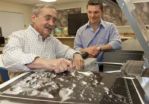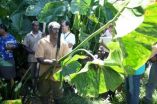(Press-News.org)
VIDEO:
Peter Schultz and graduate student Brendan Hermalyn analyzed data from bits of the Moon’s surface kicked up by a NASA-engineered collision. They found unexpected complexity -- and traces of silver....
Click here for more information.
PROVIDENCE, R.I. [Brown University] — Scientists led by Brown University are offering the first detailed explanation of the crater formed when a NASA rocket slammed into the Moon last fall and information about the composition of the lunar soil at the poles that never has been sampled. The findings are published in a set of papers in Science stemming from the successful NASA mission, called LCROSS for Lunar CRater Observing and Sensing Satellite.
Mission control at NASA Ames sent the emptied upper stage of a rocket crashing into the Cabeus crater near the Moon's south pole last October. A second spacecraft followed to analyze the ejected debris for signs of water and other constituents of the super-chilled lunar landscape.
In one of the papers, Brown planetary geologist Peter Schultz and graduate student Brendan Hermalyn, along with NASA scientists, write that the cloud kicked up by the rocket's impact showed the Moon's soil and subsurface is more complex than believed: Not only did the lunar regolith — the soil — contain water, it also harbored other compounds, such as hydroxyl, carbon monoxide, carbon dioxide, ammonia, free sodium, and, in a surprise, silver.
Combined, the assortment of volatiles — the chemical elements weakly attached to regolith grains — gives scientists clues where they came from and how they got to the polar craters, many of which haven't seen sunlight for billions of years and are among the coldest spots in the solar system.
Schultz, lead author on the Science paper detailing the impact crater and the ejecta cloud, thinks many of the volatiles originated with the billions of years-long fusillade of comets, asteroids and meteoroids that have pummeled the Moon. He thinks an assortment of elements and compounds, deposited in the regolith all over the Moon, could have been quickly liberated by later small impacts or could have been heated by the sun, supplying them with energy to escape and move around until they reached the poles, where they became trapped beneath shadows of the frigid craters.
"This place looks like it's a treasure chest of elements, of compounds that have been released all over the Moon," Schultz said, "and they've been put in this bucket in the permanent shadows."
Schultz believes the variety of volatiles found in Cabeus crater's soil implies a kind of tug of war between what is being accumulated and what is being lost to the tenuous lunar atmosphere.
"There's a balance between delivery and removal," explained Schultz, who has been on the Brown faculty since 1984 and has been studying the Moon since the 1960s. "This suggests the delivery is winning. We're collecting material, not simply getting rid of it."
Astronauts sent as part of NASA's Apollo missions found trace amounts of silver, along with gold, on the near-side (Earth-facing side) of the Moon. The discovery of silver at Cabeus crater suggests that silver atoms throughout the moon migrated to the poles. Nevertheless, the concentration detected from Cabeus "doesn't mean we can go mining for it," Schultz said.
The crater formed by the rocket's impact within Cabeus produced a hole 70 to 100 feet in diameter and tossed up six-foot deep lunar material. The plume of debris kicked up by the impact reached more than a half-mile above the floor of Cabeus, high enough to rise into sunlight, where its properties could be measured for almost four minutes by a variety of spectroscopic instruments. The amount of ejecta measured was almost two tons, the scientists report. The scientists also noted there was a slight delay, lasting roughly one-third of a second, in the flash generated after the collision. This indicated to them that the surface struck may be different than the loose, almost crunchy surface trod by the Apollo astronauts.
"If it had been simply lunar dust, then it would have heated up immediately and brightened immediately," Schultz said. "But this didn't happen."
The scientists also noticed a one-half-mile, near-vertical column of ejecta still returning to the surface. Even better, the LCROSS spacecraft was able to observe the plume as it followed on the heels of the crashing rocket. Schultz and Hermalyn had observed such a plume when conducting crater-impact experiments using hollow spheres (that mimicked the rocket that crashed into Cabeus) at the NASA Ames Vertical Gun Range in California before the LCROSS impact.
"This was not your ordinary impact," Hermalyn said. "So in order to understand what we were going to see (with LCROSS) and maybe what effects that would have on the results, we had to do all these different experiments."
Even though the mission has been judged a success, Schultz said it posed at least as many questions as it answered.
"There's this archive of billions of years (in the Moon's permanently shadowed craters)," Schultz said. "There could be clues there to our Earth's history, our solar system, our galaxy. And it's all just sitting there, this hidden history, just begging us to go back."
INFORMATION:
Contributing authors on the paper include Anthony Colaprete, Kimberly Ennico, Mark Shirley, and William Marshall, all from NASA Ames Research Center in California. NASA funded the research.
NASA-engineered collision spills new Moon secrets
2010-10-22
ELSE PRESS RELEASES FROM THIS DATE:
Stanford study links cancer to loss of protein that hooks skin cells together
2010-10-22
STANFORD, Calif. — In a study to be published online Oct. 21 in PLoS Genetics, researchers at the Stanford University School of Medicine have implicated the lack of a protein important in hooking our skin cells together in the most common variety of skin cancer. Depletion of this protein, called Perp, could be an early indicator of skin cancer development, and could be useful for staging and establishing prognoses.
These findings' significance may extend beyond skin cancer, as Perp is found in the linings of many of our internal organs, where it plays the same role it ...
Protein injection shows promise in lowering elevated triglycerides
2010-10-22
Injecting a protein that helps break down triglycerides may someday help treat an inherited form of high triglycerides, according to a new study in Arteriosclerosis, Thrombosis, and Vascular Biology, an American Heart Association journal.
Triglyceride is a type of fat in the blood. Elevated levels in the blood — hypertriglyceridemia — have been linked to coronary artery disease.
In the study, researchers tested a new compound in mice genetically altered to be deficient in a protein called apolipoprotein (apo)A-V, which causes them to have high blood levels of triglycerides. ...
Treating metabolic syndrome, undergoing carotid angioplasty
2010-10-22
Treating metabolic syndrome and undergoing carotid angioplasty may prevent recurrent stroke or transient ischemic attack (TIA), according to revised American Heart Association/American Stroke Association guidelines.
Last updated in 2006, the evidence-based guidelines for doctors will be published in Stroke: Journal of the American Heart Association.
"Patients who've had a stroke or TIA are at highest risk for having another event," said Karen Furie, M.D., M.P.H., writing committee chair and stroke neurologist. "Since the last update, we've had results from several studies ...
Younger brains are easier to rewire
2010-10-22
CAMBRIDGE, Mass. - A new paper from MIT neuroscientists, in collaboration with Alvaro Pascual-Leone at Beth Israel Deaconess Medical Center, offers evidence that it is easier to rewire the brain early in life. The researchers found that a small part of the brain's visual cortex that processes motion became reorganized only in the brains of subjects who had been born blind, not those who became blind later in life.
The new findings, described in the Oct. 14 issue of the journal Current Biology, shed light on how the brain wires itself during the first few years of life, ...
Efforts underway to rescue vulnerable bananas, giant swamp taro, other Pacific Island crops
2010-10-22
INFORMATION:
The Global Crop Diversity Trust (www.croptrust.org)
The mission of the Trust is to ensure the conservation and availability of crop diversity for food security worldwide. Although crop diversity is fundamental to fighting hunger and to the very future of agriculture, funding is unreliable and diversity is being lost. The Trust is the only organization working worldwide to solve this problem. The Trust is providing support for the ongoing operations of the seed vault, as well as organizing and funding the preparation and shipment of seeds from developing ...
Nightshades' mating habits strike uneasy evolutionary balance
2010-10-22
Most flowering plants, equipped with both male and female sex organs, can fertilize themselves and procreate without the aid of a mate. But this may only present a short-term adaptive benefit, according to a team of researchers led by two University of Illinois at Chicago biologists, who report that long-term evolutionary survival of a species favors flowers that welcome pollen from another plant.
"We've shown that a strong, short-term advantage experienced by individuals that have sex with themselves can be offset by long-term advantages to plant species that strictly ...
Malarial mosquitoes are evolving into new species, say researchers
2010-10-22
Two strains of the type of mosquito responsible for the majority of malaria transmission in Africa have evolved such substantial genetic differences that they are becoming different species, according to researchers behind two new studies published today in the journal Science.
Over 200 million people globally are infected with malaria, according to the World Health Organisation, and the majority of these people are in Africa. Malaria kills one child every 30 seconds.
Today's international research effort, co-led by scientists from Imperial College London, looks at ...
ESHRE publishes new PGD guidelines
2010-10-22
The four guidelines include one outlining the organisation of a PGD centre and three relating to the methods used: amplification-based testing, fluorescence in situ hybridisation (FISH)-based testing and polar body/embryo biopsy.
"The guidelines are a detailed update to the Consortium's initial PGD guidelines, published in the same journal in 2005. They have been developed as a set which, taken together, form a complete best-practice compendium," said Gary Harton, chairman of ESHRE's PGD Consortium and Head of Molecular Genetics at Reprogenetics in Livingston, New Jersey.
The ...
Forensic scientists use postmortem imaging-guided biopsy to determine natural causes of death
2010-10-22
Researchers found that the combination of computed tomography (CT), postmortem CT angiography (CTA) and biopsy can serve as a minimally invasive option for determining natural causes of death such as cardiac arrest, according to a study in the November issue of the American Journal of Roentgenology (www.ajronline.org).
In the last decade, postmortem imaging, especially CT, has gained increasing acceptance in the forensic field. However, CT has certain limitations in the assessment of natural death.
"Vascular and organ pathologic abnormalities, for example, generally ...
Peripheral induction of Alzheimer's-like brain pathology in mice
2010-10-22
Pathological protein deposits linked to Alzheimer's disease and cerebral amyloid angiopathy can be triggered not only by the administration of pathogenic misfolded protein fragments directly into the brain but also by peripheral administration outside the brain. This is shown in a new study done by researchers at the Hertie Institute of Clinical Brain Research (HIH, University Hospital Tübingen, University of Tübingen) and the German Center for Neurodegenerative Diseases (DZNE), to be published in Science on October 21, 2010.
Alzheimer's disease and a brain vascular ...

